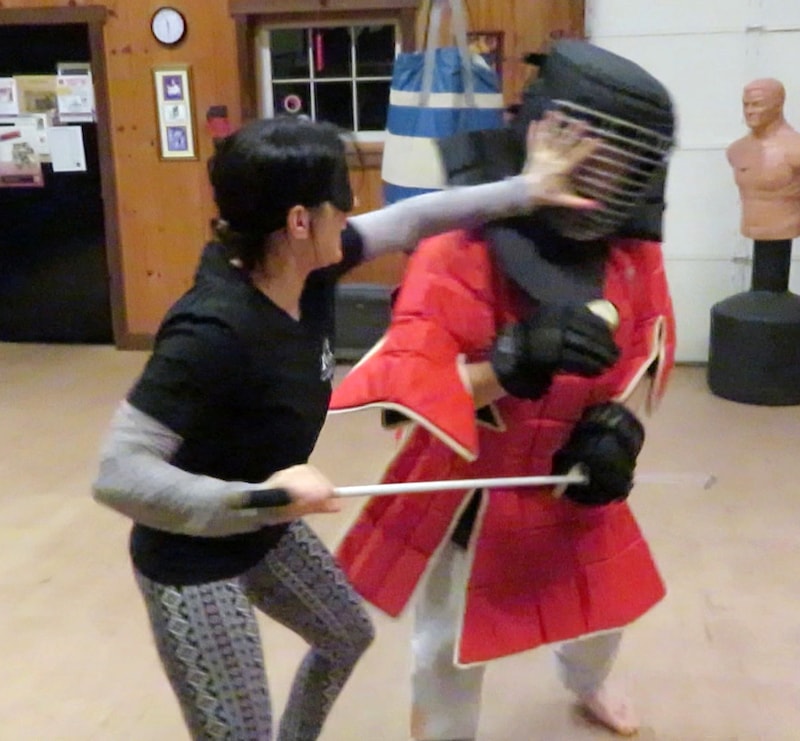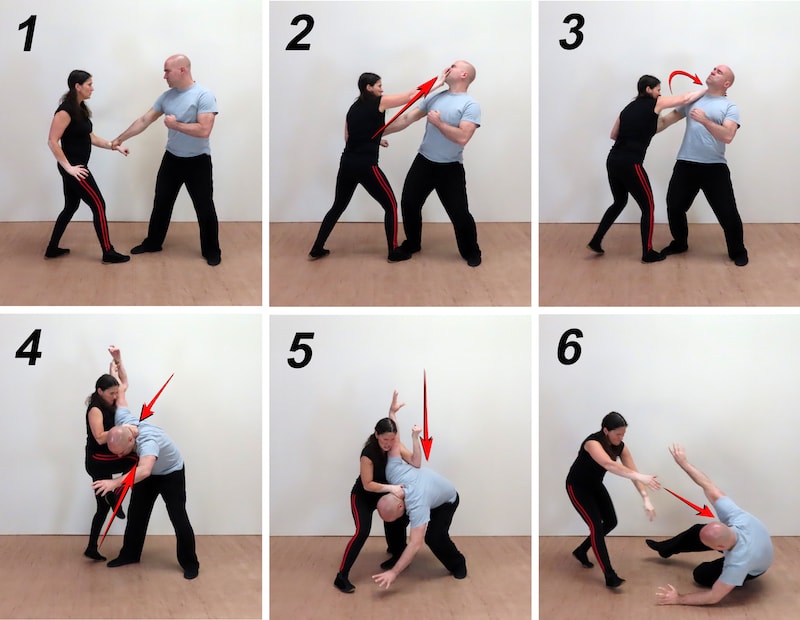By applying the scientific method, one can determine which techniques are most dependable, demonstrating the highest degree of repeatable results. Unlike heroes on television and in movies who consistently knock out villains with a single blow, you cannot depend on disabling or even discouraging an attacker with a single strike. Therefore, you should plan to attack in combinations of multiple techniques that flow smoothly into each other. Since every shot needs to elicit maximum effect, targeting is crucial. Strikes need to be chosen for maximum effect and reliability.
Necessity Is the Mother of Invention
In 2016, a gentleman with an interesting problem contacted me. His wife and daughter were both visually impaired, and given their vulnerable condition, he was very concerned that they learn to defend themselves. Since I had written a book on staff fighting, he was hoping I could give him some advice on how to effectively utilize the long white cane, a tool commonly utilized by people with impaired vision, in self-defense.
He sent me an assortment of canes, and I began testing with my advanced rank students. We took turns playing the role of attacker and blindfolded defender. After running through countless scenarios over the next couple of weeks, we discovered some interesting facts. First, the cane was almost useless as a preemptive tool. Attackers were consistently able to maneuver past it before a threat warranting its use could be perceived.
What was needed was a quick combination of super techniques, capable of inflicting significant damage even against a larger and stronger attacker. Furthermore, the defense had to be performed one handed since the victim’s other hand had to retain a hold on the cane. And of course, the techniques needed to be consistently effective even when blindfolded. What I was looking for was some sort of Grand Unified Theory for Self-defense, and after several weeks of testing, I found what I was looking for. I call the result of that study and experimentation the Tiger Claw Set of Self-Defense.

Two of my students working through scenarios to help develop a self-defense program for the visually impaired. Note the blindfold the victim is wearing. The gear her attacker is wearing was necessary since the victim was encouraged to react realistically, including striking with the cane.
The Tiger Claw Set
The Tiger Claw Set is an easily learned combination of four strikes that individually have a high probability of success in a wide variety of situations. The overall strategy is to neutralize your attacker’s fighting ability by attacking several critical body systems in rapid succession. It is designed to finish your attacker in the fewest possible moves while leaving few openings, in either time or space, for him begin to mount a defense. Having a combination that is functional in a wide range of situations minimizes your choice reaction time, allowing you to respond faster and more effectively.
The combination systematically attacks four key bodily systems: visual, circulatory, respiratory, and nervous in quick succession. Since the high stress of a self-defense situation can cause you to lose much of your fine motor control, each movement is a large, gross motor action that attacks a relatively large, vulnerable target area. These techniques are then linked in such a way that they not only flow naturally into one another but also build on the success (or failure) of the previous technique.
The standard combination has only four moves: tiger claw, chop, knee, and elbow. Each has been carefully chosen for maximum effectivity. The principle behind the Tiger Claw Set is simple: drop your attacker’s primary sensor system at the earliest opportunity before striking other various vulnerable targets until you can escape to safety.
The first attack, the tiger claw, is a linear strike that targets the attacker’s eyes. The visual system provides the brain with 80 percent of external stimuli, so impairing his vision will prevent him from mounting a strong defense. The combination of your five fingers and his two eyes gives you ten chances to score with a single strike, giving this technique a very high chance of success. A solid hit will often immediately inflict a great deal of pain as well as deprive your attacker of his major source of sensory input, making it momentarily difficult for him to continue attacking you or defending himself effectively. This shocking surprise attack has a good chance of discouraging all but the most determined attackers. If your initial strike fails to find its target, readjust and vigorously repeat the technique. Even if your attacker sees your attack coming and flinches away, he has exposed his neck for your second strike.
Since you’ve already made contact with the attacker’s head, you should have a pretty good idea where his neck is, whether you have managed to effectively strike him in the eye or not. The second technique, a short, sharp chop to the side of the neck, is delivered a fraction of a second after the eye strike. The neck is vulnerable to a classic “karate chop,” striking with the outside edge of your open hand. A sharp strike to the carotid artery located on the side of the neck can cause light-headedness and has a good chance of triggering an involuntary vagal response, stunning or even knocking out your attacker.
Once your chop lands, don’t pull it back. Rather, use it to control the attacker by grabbing his collar or hooking the back of his neck. This allows you to pull the attacker into your third attack, a knee strike to the solar plexus targeting his respiratory system, with the goal of “knocking the wind out of him,” taking away his ability to breathe.
As he doubles up in response, either from the impact of your knee against his body or merely from his flinch response to avoid being hit, he is now open for the final strike, a downward elbow to the thoracic spine delivered just between the shoulder blades (see Part 1 of Level 3 for the location of the thoracic spine). This attack on his nervous system results in weakness of the extremities and is aimed at driving your attacker to the ground.
If the attacker remains on his feet, a strong lateral push will propel him away from you, creating valuable distance between you and your attacker. It may even send him crashing to the ground.
The entire Tiger Claw combination should only take a few seconds to execute completely. With practice, you can deliver all four moves in less than three seconds.
If at any time your Tiger Claw Set fails you, just start again at the beginning. Your attacker will not know that you are performing the same combination of techniques, and you may have better luck on your second try!

Same-Side Grab: 1) Attacker’s right hand grasps your left wrist. 2) Immediately strike to the attacker’s eyes with your free hand, using the arm that is being grabbed to pull him into your strike. 3) The strike to his eyes should drive his head backward, exposing his neck. Without withdrawing your right hand very far, deliver an inner chop to the right side of the attacker’s neck. 4) Maintain contact with your attacker, hooking behind his neck with your chopping hand and pulling him into a right knee strike, doubling him over. 5) Deliver a powerful downward elbow strike to his spine, landing in a low, wide stance. 6) If your attacker is still on his feet, push him over sideways before running away.
The above is an excerpt from The Art and Science of Self Defense: A Comprehensive Instructional Guide by Joe Varady, Publication Date June 1, 2022, YMAA Publication Center, ISBN: 9781594398728.




